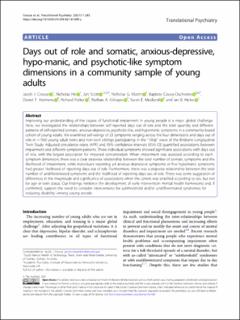| dc.contributor.author | Crouse, Jacob J. | |
| dc.contributor.author | Ho, Nicholas | |
| dc.contributor.author | Scott, Janine Linda | |
| dc.contributor.author | Martin, Nicholas G. | |
| dc.contributor.author | Couvy-Duchesne, Baptiste | |
| dc.contributor.author | Hermens, Daniel F. | |
| dc.contributor.author | Parker, Richard | |
| dc.contributor.author | Gillespie, Nathan A. | |
| dc.contributor.author | Medland, Sarah E. | |
| dc.contributor.author | Hickie, Ian B. | |
| dc.date.accessioned | 2023-02-21T15:32:06Z | |
| dc.date.available | 2023-02-21T15:32:06Z | |
| dc.date.created | 2021-12-07T13:21:10Z | |
| dc.date.issued | 2021 | |
| dc.identifier.citation | Translational Psychiatry. 2021, 11 . | en_US |
| dc.identifier.issn | 2158-3188 | |
| dc.identifier.uri | https://hdl.handle.net/11250/3052870 | |
| dc.description.abstract | Improving our understanding of the causes of functional impairment in young people is a major global challenge. Here, we investigated the relationships between self-reported days out of role and the total quantity and different patterns of self-reported somatic, anxious-depressive, psychotic-like, and hypomanic symptoms in a community-based cohort of young adults. We examined self-ratings of 23 symptoms ranging across the four dimensions and days out of role in >1900 young adult twins and non-twin siblings participating in the “19Up” wave of the Brisbane Longitudinal Twin Study. Adjusted prevalence ratios (APR) and 95% confidence intervals (95% CI) quantified associations between impairment and different symptom patterns. Three individual symptoms showed significant associations with days out of role, with the largest association for impaired concentration. When impairment was assessed according to each symptom dimension, there was a clear stepwise relationship between the total number of somatic symptoms and the likelihood of impairment, while individuals reporting ≥4 anxious-depressive symptoms or five hypomanic symptoms had greater likelihood of reporting days out of role. Furthermore, there was a stepwise relationship between the total number of undifferentiated symptoms and the likelihood of reporting days out of role. There was some suggestion of differences in the magnitude and significance of associations when the cohort was stratified according to sex, but not for age or twin status. Our findings reinforce the development of early intervention mental health frameworks and, if confirmed, support the need to consider interventions for subthreshold and/or undifferentiated syndromes for reducing disability among young people. | en_US |
| dc.language.iso | eng | en_US |
| dc.publisher | Springer Nature | en_US |
| dc.rights | Navngivelse 4.0 Internasjonal | * |
| dc.rights.uri | http://creativecommons.org/licenses/by/4.0/deed.no | * |
| dc.title | Days out of role and somatic, anxious-depressive, hypo-manic, and psychotic-like symptom dimensions in a community sample of young adults | en_US |
| dc.title.alternative | Days out of role and somatic, anxious-depressive, hypo-manic, and psychotic-like symptom dimensions in a community sample of young adults | en_US |
| dc.type | Peer reviewed | en_US |
| dc.type | Journal article | en_US |
| dc.description.version | publishedVersion | en_US |
| dc.source.pagenumber | 10 | en_US |
| dc.source.volume | 11 | en_US |
| dc.source.journal | Translational Psychiatry | en_US |
| dc.identifier.doi | 10.1038/s41398-021-01390-y | |
| dc.identifier.cristin | 1965595 | |
| dc.source.articlenumber | 285 | en_US |
| cristin.ispublished | true | |
| cristin.fulltext | original | |
| cristin.qualitycode | 1 | |

